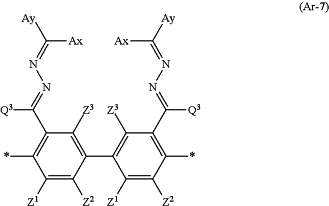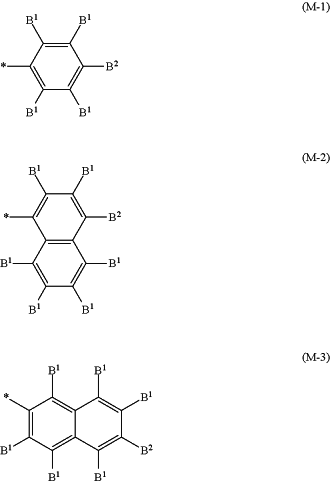| CPC C09K 19/3003 (2013.01) [C09K 19/02 (2013.01); C09K 19/3068 (2013.01); C09K 19/3491 (2013.01); G02B 5/3016 (2013.01); G02B 5/3025 (2013.01); C09K 2019/0448 (2013.01); C09K 2019/3004 (2013.01); C09K 2019/3075 (2013.01); C09K 2019/3077 (2013.01)] | 14 Claims |
|
1. A polymerizable liquid crystal composition comprising:
a compound represented by Formula (I); and
a compound represented by Formula (II),
L1-SP1-D5-(A1)a1-D3-(G1)g1-D1-[Ar-D2]q1-(G2)g2-D4-(A2)a2-D6-SP2-L2 (I)
L5-SP5-D9-(A5)a3-D10-(G3)g3-D11-M (II)
in Formula (I),
a1, a2, g1, and g2 each independently represent 0 or 1, provided that at least one of a1 or g1 represents 1, and at least one of a2 or g2 represents 1,
q1 represents 1 or 2,
D1, D2, D3, D4, D5, and D6 each independently represent a single bond; or —CO—, —O—, —S—, —C(═S)—, —CR1R2—, —CR3═CR4—, —NR5—, or a divalent linking group consisting of a combination of two or more of these groups, where R1 to R5 each independently represent a hydrogen atom, a fluorine atom, or an alkyl group having 1 to 12 carbon atoms, provided that in a case where q1 is 2, a plurality of D2's may be the same as or different from each other,
G1 and G2 each independently represent an aromatic ring having 6 to 20 carbon atoms, which may have a substituent, or a divalent alicyclic hydrocarbon group having 5 to 20 carbon atoms, which may have a substituent, and one or more of —CH2-'s constituting the alicyclic hydrocarbon group may be substituted with —O—, —S—, or —NH—,
A1 and A2 each independently represent an aromatic ring having 6 to 20 carbon atoms, which may have a substituent, or a divalent alicyclic hydrocarbon group having 5 to 20 carbon atoms, which may have a substituent, and one or more of —CH2-'s constituting the alicyclic hydrocarbon group may be substituted with —O—, —S—, or —NH—,
SP1 and SP2 each independently represent a single bond, a linear alkylene group having 1 to 12 carbon atoms, a branched alkylene group having 3 to 12 carbon atoms, or a divalent linking group in which one or more of —CH2-'s constituting the linear or branched alkylene group are substituted with —O—, —S—, —NH—, —N(Q)-, or —CO—, where Q represents a substituent,
L1 and L2 each independently represent a monovalent organic group, and at least one of L1 or L2 represents a polymerizable group, provided that in a case where Ar is an aromatic ring represented by Formula (Ar-3), at least one of L1 or L2, or L3 or L4 in Formula (Ar-3) represents a polymerizable group, and
Ar represents any of aromatic rings selected from the group consisting of groups represented by Formulae (Ar-1) to (Ar-7), provided that in a case where q1 is 2, a plurality of Ar's may be the same as or different from each other,
  in Formulae (Ar-1) to (Ar-7),
* represents a bonding position to D1 or D2,
Q1 represents N or CH,
Q2 represents —S—, —O—, or —N(R6)—, where R6 represents a hydrogen atom or an alkyl group having 1 to 6 carbon atoms,
Y1 represents an aromatic hydrocarbon group having 6 to 12 carbon atoms, which may have a substituent, an aromatic heterocyclic group having 3 to 12 carbon atoms, which may have a substituent, or an alicyclic hydrocarbon group having 6 to 20 carbon atoms, which may have a substituent, and one or more of —CH2-'s constituting the alicyclic hydrocarbon group may be substituted with —O—, —S—, or —NH—,
Z1, Z2, and Z3 each independently represent a hydrogen atom, a monovalent aliphatic hydrocarbon group having 1 to 20 carbon atoms, a monovalent alicyclic hydrocarbon group having 3 to 20 carbon atoms, a monovalent aromatic hydrocarbon group having 6 to 20 carbon atoms, a monovalent aromatic heterocyclic group having 6 to 20 carbon atoms, a halogen atom, a cyano group, a nitro group, —OR7, —NR8R9, —SR10, —COOR11, or —COR12, R7 to R12 each independently represent a hydrogen atom or an alkyl group having 1 to 6 carbon atoms, and Z1 and Z2 may be bonded to each other to form an aromatic ring,
A3 and A4 each independently represent a group selected from the group consisting of —O—, —N(R13)—, —S—, and —CO—, where R13 represents a hydrogen atom or a substituent,
X represents a hydrogen atom or a non-metal atom of Groups XIV to XVI to which a substituent may be bonded,
D7 and D8 each independently represent a single bond; or —CO—, —O—, —S—, —C(═S)—, —CR1R2—, —CR3═CR4—, —NR5—, or a divalent linking group consisting of a combination of two or more of these groups, where R1 to R5 each independently represent a hydrogen atom, a fluorine atom, or an alkyl group having 1 to 12 carbon atoms,
SP3 and SP4 each independently represent a single bond, a linear alkylene group having 1 to 12 carbon atoms, a branched alkylene group having 3 to 12 carbon atoms, or a divalent linking group in which one or more of —CH2-'s constituting the linear or branched alkylene group are substituted with —O—, —S—, —NH—, —N(Q)-, or —CO—, where Q represents a substituent,
L3 and L4 each independently represent a monovalent organic group, and at least one of L3 or L4, or L1 or L2 in Formula (I) represents a polymerizable group,
Ax represents an organic group having 2 to 30 carbon atoms, which has at least one aromatic ring selected from the group consisting of an aromatic hydrocarbon ring and an aromatic heterocyclic ring,
Ay represents a hydrogen atom, an alkyl group having 1 to 12 carbon atoms, which may have a substituent, or an organic group having 2 to 30 carbon atoms, which has at least one aromatic ring selected from the group consisting of an aromatic hydrocarbon ring and an aromatic heterocyclic ring,
the aromatic ring in each of Ax and Ay may have a substituent, and Ax and Ay may be bonded to each other to form a ring, and
Q3 represents a hydrogen atom or an alkyl group having 1 to 20 carbon atoms, which may have a substituent, and
in Formula (I),
a3 and g3 each independently represent an integer of 0 to 2, provided that a3 and g3 represent integers of 1 to 3 in total,
D9, D10, and D11 each independently represent a single bond; or —CO—, —O—, —S—, —C(═S)—, —CR1R2—, —CR3═CR4—, —NR5—, or a divalent linking group consisting of a combination of two or more of these groups, where R1 to R5 each independently represent a hydrogen atom, a fluorine atom, or an alkyl group having 1 to 12 carbon atoms,
G3 represents an aromatic ring having 6 to 20 carbon atoms or a divalent alicyclic hydrocarbon group having 5 to 20 carbon atoms and one or more of —CH2-'s constituting the alicyclic hydrocarbon group may be substituted with —O—, —S—, or —NH—, provided that in a case where g3 is 2, a plurality of G3's may be the same as or different from each other,
A5 represents an aromatic ring having 6 to 20 carbon atoms or a divalent alicyclic hydrocarbon group having 5 to 20 carbon atoms and one or more of —CH2-'s constituting the alicyclic hydrocarbon group may be substituted with —O—, —S—, or —NH—, provided that in a case where a3 is 2, a plurality of A5's may be the same as or different from each other,
SP5 represents a single bond, a linear alkylene group having 1 to 12 carbon atoms, a branched alkylene group having 3 to 12 carbon atoms, or a divalent linking group in which one or more of —CH2-'s constituting the linear or branched alkylene group are substituted with —O—, —S—, —NH—, —N(Q)-, or —CO—, where Q represents a substituent,
L5 represents a polymerizable group, and
M represents any of terminal groups selected from the group consisting of groups represented by Formulae (M-1) to (M-3),
 in Formulae (M-1) to (M-3),
* represents a bonding position to D11,
a plurality of B1's each independently represent a hydrogen atom or a substituent, and
B2 represents a hydrogen atom or a fluorine atom.
|